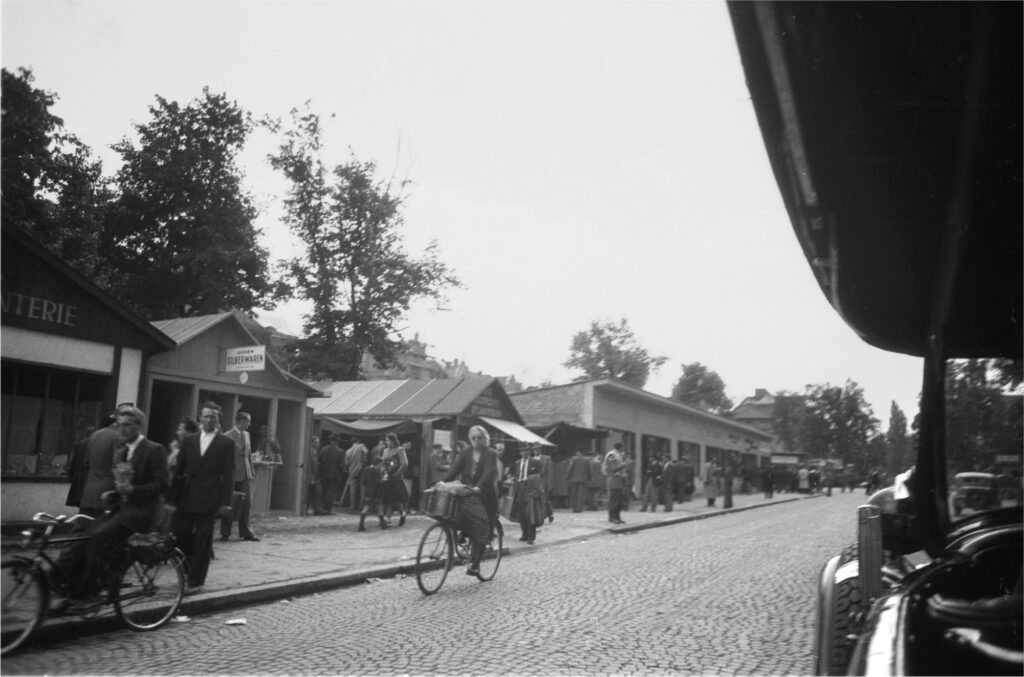
Angela Bottin paid a visit to the exhibition. She is an advisor to the White Rose Foundation in Munich and is working on a book about Hans Leipelt who supported the White Rose, and his sister Maria. Bogenhausen has played an important role in her research on the post-war era. She wrote the following to us:
On November 24, 2023 I had the opportunity to go and see the exhibition “Munich Displaced. The Surviving Remnant” at the Jewish Museum Munich. The day before, I had walked down Möhlstrasse tracing the footsteps of Maria Leipelt (1925–2008), turned into Siebertstrasse and stopped at the junction with Maria-Theresia-Strasse: to my left, I looked at the “Hildebrandhaus,” now Monacensia, No. 23 Maria-Theresia-Strasse; to my right, my gaze fell on the villa with the address Siebertstrasse 3. Thanks to my many years of research into the history of the Leipelt family, I knew that Maria had worked for the aid organization “American Jewish Joint Distribution Committee” (JOINT) that had its headquarters in Siebertstrasse. Following her release from prison on April 14, 1945, where she had been held as a political prisoner—last of all in Bayreuth-St. Georgen—she was employed by the American military government in Bayreuth and initially worked for the aid organization UNRRA, where she wore an American uniform herself. Many of her relatives had been victims of the Holocaust. Her brother, the chemistry student Hans Konrad Leipelt, was murdered in Stadelheim Prison in Munich on January 29, 1945, for his resistance against National Socialism. Maria, the only member of her family to survive, then committed herself to helping Displaced Persons, while desperately hoping herself for an opportunity to leave Germany.
Once again I found myself looking for places in Munich which played a significant role in Hans and Maria Leipelt’s bigraphies. This took me to Siebertstrasse on that November day. However, I did not know the house number at that time and was not able to identify it definitively.
Looking forward to the exhibition, I went to the Jewish Museum the next day. As soon as I entered the first exhibition room, I found myself—totally unexpectedly—in Möhlstrasse in the early post-war period. Two large-format projections, placed next to each other, transported me back to a reality from long ago which could not have created a greater contrast to the impressions I had of the previous day of the prestigious Möhlstrasse of 2023, lined with impressive buildings. On both sides of the street there were wooden huts that housed shops and businesses used by the DPs.

Shops and institutions supporting people who had lost everything—not just their Heimat. Projected on a screen in between, quotes from contemporary witnesses could be read. And there were film clips of a protest march down Möhlstrasse by Jewish survivors, accompanied by members of the American military government in Munich. This demonstration of solidarity was triggered by the British government’s refusal to allow passengers on the refugee ship Exodus 1947—all Holocaust survivors—to enter the British mandate of Palestine. One important stop on the Exodus 1947’s return journey was the port of Hamburg, Maria’s birthplace. Maria Leipelt also seriously considered emigrating to Palestine. She worked hard learning Hebrew. Under the dramatic circumstances of the summer in 1947, it was a stroke of good luck for the young woman, who was still not of age, that the doctor and pharmacologist Susi Glaubach was preparted to stand surety for Maria Leipelt in the USA and enable her to enter the country as a stateless person. Susi Glaubach herself was Jewish and had fled from Vienna to New York in summer 1938 to escape the Nazis. Her closest confidante, Dr. Katharina Leipelt, Hans and Maria’s mother, had accompanied her by train to Bremerhaven after stopping by the Leipelts in Hamburg. They were never to see each other again. Maria’s identity for her emigration on June 6, 1946 was confirmed by ID card no. 21 from the Hebrew Immigrant Aid Society (HIAS), Munich (photo: see above). She had previously worked for the HIAS.
My route through the exhibition took me past several places in Munich and finally to Siebertstrasse 3: On a photo I recognized the villa opposite the Hildebrandhaus that I had seen the previous day and read the sign on the metal garden fence: “American Joint Distribution Committee. Central Committee of Liberated Jews in Bavaria.” So this was where Maria Leipelt had worked before she managed to leave the country of the perpetrators.

November 29, 2023, Angela Bottin
We are glad that our exhibition was able to close a gap in the research on Maria Leipelt and are very much looking forward to the publication on her and her brother Hans which is planned for 2025.
The exhibition “Munich Displaced. The Surviving Remnant” is a stocktaking on Munich’s post-war history. Much detailed information as well as photos and memorabilia are still missing. In the meantime, visitors, descendants of Displaced Persons (DPs) from Munich and other interested parties have shared their memories with us.
